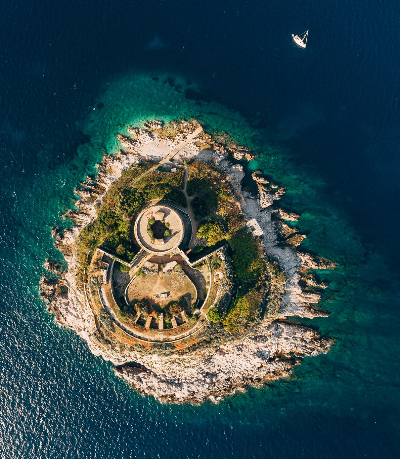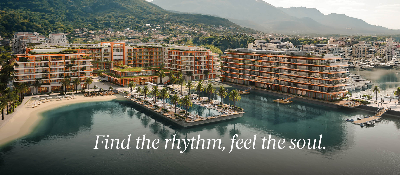
©
Чорногорія — морська країна з 290 км узбережжя Адріатичного моря — стрімко перетворюється на центр елітної забудови. За останні 20 років держава передала дев’ять прибережних і гірських ділянок загальною площею 900 гектарів в довгострокову оренду (на 30–90 років). Серед інвесторів — компанії з ОАЕ, Греції, Швейцарії. З одного боку, країна приваблює стабільним податковим режимом (9–15%), вільним доступом до нерухомості для іноземців, сприятливим кліматом і вигідним розташуванням. Масштабні проєкти Porto Montenegro, Lustica Bay, Portonovi — це вже візитівки нової туристичної Чорногорії. З іншого — громадськість дедалі гучніше критикує втрату культурних та історичних об’єктів, а також брак прозорості в процесах оренди. НУО Action for Social Justice (ASP) заявляє про серйозні екологічні ризики та шкоду для місцевих громад. Деякі проєкти спричинили протести, судові суперечки та навіть зупинення будівництва. Що віддала Чорногорія в довгострокову оренду?
Порто Монтенегро — реконструкція верфі в Тіваті в пристань для мегаяхт і люкс-готель. Інвестиції — понад €500 млн.
Свєті Стефан — історичний курорт (готелі Sveti Stefan, Milocer), зданий в оренду компанії Adriatic Properties у 2007 р. (€50 млн інвестицій). Від 2021 р. готелі зачинені через конфлікт з місцевою владою та судові позови.
Затока Луштиця — 90-річна оренда майже 700 га на півострові Луштиця, інвестиції €1,1 млрд. Реалізовано — близько €450 млн.
Острів Мамула — острів з австрійською фортецею XIX ст., колишня в’язниця. З 2015 р. — курорт, €36 млн інвестицій. Історичну цінність перетворено на готельний комплекс.
Монтероз — 50 га на Луштиці, інвестиції мали скласти €140 млн. У 2022 р. інвестор розірвав договір та подав позов у Лондоні.
Колашин — гірськолижний курорт у Б’єласіці. 90-річна оренда 27 га, заплановано €77 млн. Побудовано 3 готелі, один працює.
Нещодавно в Ульцині відбулися масові демонстрації проти планів передати в оренду пляжі, зокрема Велика Плажа — один з найдовших піщаних пляжів Адріатики. Громади вважають нові тендери загрозою для місцевого бізнесу та відкритого доступу до моря. Більшість контрактів було укладено за уряду Демократичної партії соціалістів Міло Джукановича (до 2020 року). Після зміни влади процедури стали жорсткішими, проте громадськість вимагає перегляду попередніх договорів і більше прозорості в майбутньому.
Montenegro's Coastal Development: Investment or Exploitation?
Montenegro — a maritime country with 290 km of coastline along the Adriatic Sea — is rapidly transforming into a center for elite real estate development. Over the past 20 years, the country has leased nine coastal and mountain plots, totaling 900 hectares, for long-term periods (30–90 years). Investors from the UAE, Greece, and Switzerland are among those involved. On one hand, the country attracts investors due to its stable tax regime (9-15%), unrestricted access to real estate for foreigners, a favorable climate, and a strategic location. Large-scale projects like Porto Montenegro, Lustica Bay, and Portonovi have already become icons of Montenegro’s new tourism sector. On the other hand, the public is increasingly criticizing the loss of cultural and historical landmarks, as well as the lack of transparency in the leasing processes. NGOs like Action for Social Justice (ASP) raise concerns about significant environmental risks and harm to local communities. Some projects have led to protests, legal disputes, and even halted construction:
Porto Montenegro — the reconstruction of a shipyard in Tivat into a yacht marina and luxury hotel. Investments — over €500 million.
Sveti Stefan — a historic resort (Sveti Stefan, Milocer hotels), leased to Adriatic Properties in 2007 (€50 million investments). Since 2021, the hotels have been closed due to disputes with local authorities and lawsuits.
Lustica Bay — a 90-year lease of nearly 700 hectares on the Lustica Peninsula, with investments of €1.1 billion. So far, €450 million has been invested.
Mamula Island — an island with an Austrian fortress from the 19th century, formerly a prison. Since 2015, it has been turned into a resort with €36 million in investments.
Monterose — 50 hectares on Lustica, with planned investments of €140 million. In 2022, the investor terminated the contract and filed a lawsuit in London.
Kolašin 1600 — a ski resort in Bjelasica. A 90-year lease of 27 hectares, with planned investments of €77 million. Three hotels have been built, with one operational.
In 2025, mass protests took place in Ulcinj against plans to lease beaches, including the famous Velika Plaža — one of the longest sandy beaches on the Adriatic. Local communities see the new tenders as a threat to local businesses and public access to the sea. Most of the contracts were signed under the government of the Democratic Party of Socialists (until 2020). After the change in power, procedures became stricter, but the public demands a review of previous agreements and greater transparency in the future.

©
872